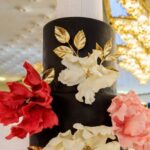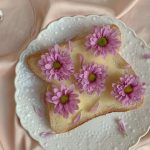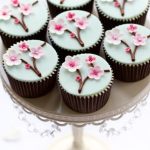Decorative flowers on cakes can elevate any baked creation from ordinary to extraordinary. These delicate and beautiful blossoms add a whimsical and enchanting touch that delights both the eyes and taste buds. Whether you’re a professional baker or simply someone who enjoys creating edible works of art, mastering the art of making decorative flowers for cakes is a skill worth acquiring.
In this blog post, we will explore various techniques and materials needed to craft these charming floral decorations. From basic supplies like fondant or gum paste to advanced shaping techniques and creative ideas for incorporating the flowers into cake designs, we’ll cover it all.
Whether you’re looking to create floral arrangements for wedding cakes, birthday cakes, or themed desserts, this article will provide you with the knowledge and inspiration to transform your baked goods into stunning works of art.
Throughout this post, we will walk you through step-by-step instructions on preparing the fondant or gum paste properly, shaping beautiful flowers using different tools and molds, coloring them realistically, assembling different flower components into cohesive arrangements, and even exploring advanced techniques like veining and frilling. With each technique explained in detail and backed up by helpful visuals, you’ll be able to create intricate floral designs that will impress anyone who lays eyes on them.
So let’s delve into the world of edible artistry as we embark on this journey of crafting decorative flowers for cakes. Discover the secrets behind these botanical beauties that are sure to take your cake decorating skills to new heights.
Basic Supplies
To create beautiful decorative flowers for cakes, it is important to have the right supplies on hand. Here is a comprehensive list of the necessary tools and materials you will need:
- Fondant or Gum Paste: These are pliable and edible materials that can be shaped into intricate flower designs. Fondant is smoother and easier to work with, while gum paste dries faster and holds its shape better.
- Flower Cutters: These specialized tools come in various shapes and sizes, allowing you to cut out petals, leaves, and other flower components with precision. Choose cutters that match the flower shapes you wish to create.
- Rolling Pin: A rolling pin is essential for rolling out the fondant or gum paste to the desired thickness. Opt for a non-stick rolling pin to prevent sticking or use a dusting of cornstarch or powdered sugar if needed.
- Edible Coloring Options: Depending on your design, there are different ways to add color to your flowers. Gel-based food colors offer vibrant hues without altering the consistency of the fondant or gum paste. Edible dusts can be brushed onto dry flowers for subtle shading effects, while edible paints allow for more intricate details.
- Foam Pads and Flower Formers: Foam pads provide a soft surface for thinning and shaping flower petals, while flower formers help create realistic curves and dimensions as the flowers dry.
- Ball Tools: Ball tools come in various sizes and are used to thin edges of petals, create veins, or add texture to flower centers.
- Piping Tips and Tubes: Piping tips can be used to create small stamens for certain flowers or add delicate finishing touches. Tubes help maintain the shape of rolled-up petals as they dry.
- Wire Cutters: If you plan on incorporating wired elements into your floral arrangements (such as stems), wire cutters are essential for cutting floral wires to size.
| Supplies | Description |
|---|---|
| Fondant or Gum Paste | Pliable and edible materials for shaping flowers |
| Flower Cutters | Specialized tools for cutting flower components with precision |
| Rolling Pin | Essential for rolling out fondant or gum paste |
| Edible Coloring Options | Gel-based food colors, edible dusts, and edible paints for adding color to flowers |
These are just some of the basic supplies you will need to start creating decorative flowers for cakes. Having the appropriate tools and materials will make the process easier and help you achieve stunning results. Now that you have your supplies ready, let’s move on to the next step – preparing the fondant or gum paste.
Preparing the Fondant or Gum Paste
To create beautiful and realistic decorative flowers for cakes, it is important to start with properly prepared fondant or gum paste. This section will guide you through the steps to ensure that your fondant or gum paste is ready for shaping and molding into stunning floral designs.
Firstly, it is essential to have clean hands and a clean working surface before handling the fondant or gum paste. This will prevent any unwanted debris or dirt from contaminating your flowers.
Next, take a small portion of fondant or gum paste and begin kneading it gently in your hands. Kneading helps to soften the fondant or gum paste and make it more pliable for shaping. Continue kneading until it becomes smooth and elastic.
Once the fondant or gum paste is adequately kneaded, it’s time to roll it out to the desired thickness. Dust your work surface with a thin layer of cornstarch or icing sugar to prevent sticking. Then, use a rolling pin to roll out the fondant or gum paste evenly, maintaining an even thickness throughout.
It’s important to note that the ideal thickness may vary depending on the size and type of flower you intend to create. Most commonly, a thickness of about 1/8 inch (3 mm) is suitable for most flower designs.
To aid in achieving an even thickness, consider using spacers on either side of the fondant or gum paste when rolling it out. These spacers can be made by cutting strips of thin cardboard or using specific rolling pin guides designed for this purpose.
By following these steps, you can ensure that your fondant or gum paste is properly prepared for creating decorative flowers for cakes. The next section will explore various techniques for shaping and molding these flowers using your prepared fondant or gum paste.
- Clean hands and working surface
- Knead fondant/gum paste until smooth and elastic
- Dust work surface with cornstarch or icing sugar
- Roll out fondant/gum paste evenly to desired thickness of about 1/8 inch (3 mm)
- Consider using spacers for an even thickness
Flower Shaping Techniques
When it comes to creating decorative flowers for cakes, the shaping technique you choose can greatly impact the final result. There are several techniques that can be used to shape and mold flowers with fondant or gum paste, each offering its own unique look and texture. Here are a few popular techniques to consider:
- Flower Formers: Flower formers are specially designed tools that help give your flowers a more natural shape and dimension. They typically consist of concave shapes in different sizes that allow you to lay your petals on top and create a realistic curve. To use flower formers, simply place your petals on the concave surface and let them dry until they hold their desired shape.
- Molds: Using molds is another great way to shape your flowers with precision and consistency. There are various flower molds available in the market that come in different shapes and sizes, allowing you to create lifelike petals, centers, and even leaves. To use a mold, press your fondant or gum paste into the mold cavities, remove any excess using a sharp knife or palette knife, and carefully release the molded pieces.
- Individual Hand Shaping: For a more personalized touch, hand shaping allows you to sculpt each petal individually according to your desired design. This technique requires some practice but offers endless possibilities for creating unique flower shapes and textures.
To hand shape your flowers, roll out your fondant or gum paste thinly and cut out individual petals using flower cutters. Then gently manipulate each petal by cupping it with your fingers or using modeling tools to add curves or ruffles.
Experimenting with different shaping techniques is key to achieving stunning floral designs on cakes. By combining these techniques or even utilizing them separately for different types of flowers, you can create a variety of intricate and visually captivating decorations that will elevate your cake designs to the next level.
Coloring and Painting
Coloring and painting are essential aspects of creating decorative flowers for cakes. Adding vibrant colors not only enhances the visual appeal of the flowers but also allows for more creativity in cake designs. There are several methods to color and paint fondant or gum paste flowers, including using gel-based food colors, edible dust, or edible paint.
One popular option for coloring flowers is using gel-based food colors. These colors are highly concentrated and provide intense hues without altering the texture of the fondant or gum paste. To use gel-based food colors, a small amount is added to the fondant or gum paste and kneaded until it is evenly distributed. The color can be adjusted by adding more or less depending on the desired shade.
Edible dust is another effective way to add color to flowers. Edible dust comes in powdered form in a variety of shades and can be applied directly onto the petals with a dry brush. This method allows for achieving realistic gradients and highlights by selectively applying dust to create depth and dimension in the flower design.
For those looking for more intricate details or artistic effects, edible paint can be used. Edible paints are available in liquid form and can be applied with a brush just like traditional paint. This technique allows for more creative freedom in terms of blending colors, creating shading effects, or even adding decorative patterns on the petals.
When using any coloring method, it is important to start with a small amount of color and gradually add more if needed to avoid overpowering the design. It is also advisable to work on a non-stick surface such as a silicone mat to prevent sticking and allow for easy cleaning.
Overall, coloring and painting techniques provide endless possibilities for creating beautiful and realistic floral designs on cakes. Experimenting with different methods and combinations can lead to stunning results that will impress both clients and guests alike.
| Coloring Method | Advantages |
|---|---|
| Gel-Based Food Colors | – Highly concentrated colors
|
| Edible Dust | – Allows for realistic gradients and highlights
|
| Edible Paint | – Offers more intricate details and artistic effects
|
Assembling the Flowers
Once you have prepared the fondant or gum paste and shaped your flowers using the techniques mentioned earlier, it’s time to assemble them into a beautiful floral arrangement for your cake. This step will bring all your hard work together and create a stunning centerpiece for your dessert.
Start by gathering all the individual flower components you have created – petals, centers, and leaves. Lay them out in front of you so you can easily access them during the assembly process. Take a moment to visualize how you want your flowers to look and consider the overall design of your cake.
To begin assembling the flowers, take one petal at a time and add a small dab of water or edible glue onto its bottom edge. Gently press it onto the center of the flower, making sure it adheres firmly. Repeat this step with each petal, working from the outermost layer towards the center. As you add each petal, slightly overlap them to create a natural-looking effect.
Once all the petals are attached to the center, it’s time to add some leaves if desired. Apply a small amount of water or edible glue onto one side of a leaf and carefully position it next to the flower’s base. Press down gently until it sticks securely in place. Repeat this step with additional leaves until you achieve your desired look.
Continue this process with each individual flower component until all your flowers are assembled. Make sure to leave enough space between each flower on your cake so that they stand out and don’t overcrowd one another. Once complete, step back and admire your beautiful floral arrangement.
By following these steps and using your creativity when arranging the flowers on your cake, you can achieve a visually stunning result that will impress everyone who sees it. Don’t be afraid to experiment with different flower combinations, sizes, and placements to find what works best for your specific cake design. Have fun and enjoy the process of bringing these decorative flowers to life.
Advanced Techniques
Advanced Techniques: Creating Intricate Flower Designs
Creating intricate flower designs can take your cake decorations to the next level. These advanced techniques allow you to add exquisite details and texture to your floral arrangements, making them truly stand out. In this section, we will introduce several advanced techniques for creating stunning flower designs using fondant or gum paste. We will provide step-by-step instructions and include helpful visuals to guide you through the process.
Ruffling
Ruffling is a technique that adds delicate waves and movement to flower petals. To achieve this effect, start by rolling out a thin sheet of fondant or gum paste. Using a ball tool or the rounded end of a paintbrush, gently roll along the edge of each petal to create a ruffled appearance.
You can vary the intensity of the ruffles by applying more pressure as you go. Repeat this process for each petal, and then shape and assemble the petals as desired.
Frilling
Frilling is similar to ruffling but creates larger, more dramatic waves in the petals. Begin by cutting out the desired shape of your petal using a flower cutter. Use either your fingers or a frilling tool to thin out the edges of the petal while keeping the center thicker.
This will create depth and movement in your design. Next, gently pull and stretch one edge of the petal towards its center, repeating this process with each section until you achieve your desired frilled effect.
Veining and Adding Petal Details
Veining adds realistic texture to flower petals by replicating natural veins found in real flowers. First, roll out a thin layer of fondant or gum paste and place it on a veining mat or silicone mold with veining patterns. Gently press down on the mat/mold to create impressions on the surface of your petal or leaf shape.
Remove the paste carefully from the mat/mold to reveal the detailed veins. You can further enhance your flowers by adding additional details such as stamens, pistils, or tiny dots. These small touches will bring your flowers to life and add a professional finish.
By mastering these advanced techniques, you can create intricate flower designs that are sure to impress. Experiment with different shapes, colors, and combinations to achieve unique and stunning results. Remember, practice makes perfect, so don’t be discouraged if it takes a few tries to get it just right. Your persistence will pay off when you see the final result on top of a beautifully decorated cake.
With these advanced techniques in your arsenal, you can take your cake decorating skills to new heights. Let your creativity soar as you delve into the world of intricate flower designs for cakes.
Storage and Transportation
Storing Decorative Flowers
After spending time and effort creating beautiful decorative flowers for your cakes, it’s important to store them properly to ensure they maintain their shape and quality. Here are some best practices for storing your finished flowers:
- Use airtight containers: Place the flowers in airtight containers to protect them from humidity and moisture, which can cause them to wilt or become sticky. Choose containers that are large enough to accommodate the size of your flowers without squishing or deforming them.
- Layer with parchment paper: To prevent the flowers from sticking together or losing their shape during storage, layer them with parchment paper. This will create a barrier between each flower, keeping them separate and intact.
- Store in a cool, dry place: Find a cool and dry spot to store your decorative flowers, away from direct sunlight and extreme temperatures. Excessive heat can cause the colors to fade or melt, while excessive cold can make the flowers brittle.
Transporting Decorative Flowers
When it comes to transporting your delicately crafted decorative flowers, there are a few precautions you should take to keep them safe and intact:
- Secure packaging: Invest in packaging materials specifically designed for transporting delicate items like cake decorations. Look for boxes or containers with dividers or compartments to hold each flower securely in place without crushing or damaging them.
- Cushioning material: Fill any empty spaces in the container with tissue paper or foam padding to provide an extra layer of protection against movement during transportation. This will help prevent the flowers from shifting around and potentially breaking.
- Handle with care: When carrying the container holding your decorative flowers, make sure to hold it steady and avoid any sudden movements that could jostle or dislodge the delicate flowers.
Remember that some advanced techniques might result in more fragile flower designs, so extra care may be needed during transportation and storage. By following these best practices, you can ensure that your decorative flowers arrive at their destination in pristine condition, ready to be admired and placed on a beautiful cake.
Overall, storing and transporting decorative flowers requires gentle handling and the use of appropriate materials. With proper care, you can preserve the integrity of your flowers and showcase them in all their exquisite glory on a cake for everyone to admire.
Creative Ideas for Decorating Cakes
Cake decoration is an art form that allows for limitless creativity and expression. One of the most beautiful and versatile elements in cake design is decorative flowers. These delicate and intricate flowers can elevate any cake, whether it’s for a wedding, birthday, or themed event. In this section, we will explore some creative ideas for decorating cakes using decorative flowers.
For wedding cakes, decorative flowers can be used to create a stunning centerpiece. Consider incorporating large, statement flowers like roses or peonies as the focal point of the cake. Surround these focal flowers with smaller blooms like hydrangeas or daisies to add depth and texture. You can also use flowers to create cascading designs that flow down the tiers of the cake, giving it an elegant and romantic look.
When it comes to birthday cakes, you can have fun with different themes and color palettes. For a garden-themed cake, use an assortment of vibrant and colorful flowers like sunflowers, tulips, or daffodils. If you’re designing a princess-themed cake, opt for delicate and pastel-colored flowers like cherry blossoms or lilacs. Another fun idea is to create a flower crown around the top edge of the cake as a sweet surprise for the birthday celebrant.
Themed cakes allow for even more creative possibilities. For example, if you’re designing a beach-themed cake, incorporate tropical flowers like hibiscus or orchids in bright colors such as hot pink or orange. A rustic-themed cake could feature wildflowers like lavender or poppies arranged in a loose and natural style. The key is to think about the theme or occasion and choose flowers that complement it.
Incorporating decorative flowers into your cake designs adds not only beauty but also a personal touch. Whether you’re going for an elegant wedding cake, a playful birthday design, or a themed creation, these floral accents will surely make your cakes stand out from the rest. Let your imagination run wild and create stunning edible art that will be the highlight of any celebration.
Conclusion
In conclusion, this blog post has provided a comprehensive guide on how to make decorative flowers for cakes. We have covered everything from the basic supplies needed to the advanced techniques for creating intricate designs. By following the step-by-step instructions and helpful visuals provided, readers can confidently try their hand at making these beautiful flowers.
To achieve exceptional results, it is important to pay attention to details such as properly preparing the fondant or gum paste, mastering various flower shaping techniques, and using vibrant colors to add realism to the flowers. Additionally, practicing advanced techniques like ruffling, frilling, veining, and adding petal details can take your floral arrangements to the next level.
Once you have created a variety of decorative flowers, consider incorporating them into creative cake designs. From elegant wedding cakes to fun-themed birthday cakes, these flowers can be a stunning addition that elevates any cake design. Let your imagination run wild and experiment with different placements and arrangements.

Welcome to my blog about home and family. This blog is a place where I will share my thoughts, ideas, and experiences related to these important topics. I am a stay-at-home mom with two young children. I hope you enjoy reading it! and may find some helpful tips and ideas that will make your home and family life even better!





